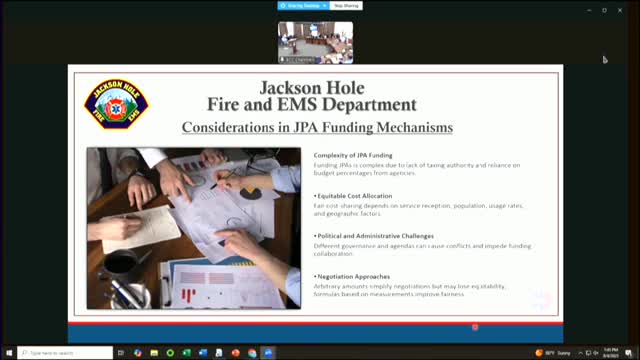Jackson Hole Fire EMS explores cost allocation strategies for equitable funding
August 04, 2025 | Jackson, Teton County, Wyoming
This article was created by AI summarizing key points discussed. AI makes mistakes, so for full details and context, please refer to the video of the full meeting. Please report any errors so we can fix them. Report an error »

The Jackson - Town Council Joint Information Meeting held on August 4, 2025, focused on the complexities of funding for emergency services, specifically the Jackson Hole Fire EMS. The meeting aimed to address the challenges of equitable funding among various organizations and explore potential strategies for cost allocation.
The discussion began with an overview of the Joint Powers Agreement (JPA) funding, highlighting the unequal funding challenges faced by different organizations. Factors such as service reception, population, usage rates, and geographic considerations were identified as key elements influencing cost-sharing. The speaker emphasized the importance of developing formulas based on measurable factors to enhance fairness in funding negotiations.
Eight potential funding strategies were presented, each with its strengths and weaknesses. The first strategy discussed was based on call volume, where funding is allocated according to the number of emergency calls made in each jurisdiction. While straightforward, this method may not accurately reflect the true service needs of different communities due to varying types of calls.
The second strategy involved assessed property values, which could lead to disparities in funding based on the economic status of different areas. The third option focused on response areas, while the fourth considered facility and fleet expenses. Each of these strategies was scrutinized for its potential to distort funding needs based on call volume or resource distribution.
The meeting also explored staffing levels as a basis for funding, as well as population size, which could drive service demand. However, the limitations of these models were acknowledged, particularly in addressing demographic disparities that may affect service usage.
A combined factors approach was proposed, integrating multiple elements such as staffing, incident counts, and population served. This method allows for a more nuanced understanding of funding needs but requires careful negotiation on which factors to prioritize. The final strategy discussed was a weighted combination of factors, which assigns different levels of importance to each element, allowing for tailored funding solutions.
Throughout the meeting, participants raised questions about data collection and the feasibility of implementing these strategies. It was noted that much of the necessary data is already collected, but further refinement may be needed to ensure accuracy in future assessments.
In conclusion, the meeting underscored the necessity of collaborative discussions to establish a fair and effective funding model for emergency services in Jackson and Teton County. The recommended approach is the weighted combination of factors, which acknowledges the complexity of service demands while providing flexibility for negotiation. Future meetings will be essential to finalize the funding strategy and ensure ongoing cooperation between the involved parties.
The discussion began with an overview of the Joint Powers Agreement (JPA) funding, highlighting the unequal funding challenges faced by different organizations. Factors such as service reception, population, usage rates, and geographic considerations were identified as key elements influencing cost-sharing. The speaker emphasized the importance of developing formulas based on measurable factors to enhance fairness in funding negotiations.
Eight potential funding strategies were presented, each with its strengths and weaknesses. The first strategy discussed was based on call volume, where funding is allocated according to the number of emergency calls made in each jurisdiction. While straightforward, this method may not accurately reflect the true service needs of different communities due to varying types of calls.
The second strategy involved assessed property values, which could lead to disparities in funding based on the economic status of different areas. The third option focused on response areas, while the fourth considered facility and fleet expenses. Each of these strategies was scrutinized for its potential to distort funding needs based on call volume or resource distribution.
The meeting also explored staffing levels as a basis for funding, as well as population size, which could drive service demand. However, the limitations of these models were acknowledged, particularly in addressing demographic disparities that may affect service usage.
A combined factors approach was proposed, integrating multiple elements such as staffing, incident counts, and population served. This method allows for a more nuanced understanding of funding needs but requires careful negotiation on which factors to prioritize. The final strategy discussed was a weighted combination of factors, which assigns different levels of importance to each element, allowing for tailored funding solutions.
Throughout the meeting, participants raised questions about data collection and the feasibility of implementing these strategies. It was noted that much of the necessary data is already collected, but further refinement may be needed to ensure accuracy in future assessments.
In conclusion, the meeting underscored the necessity of collaborative discussions to establish a fair and effective funding model for emergency services in Jackson and Teton County. The recommended approach is the weighted combination of factors, which acknowledges the complexity of service demands while providing flexibility for negotiation. Future meetings will be essential to finalize the funding strategy and ensure ongoing cooperation between the involved parties.
View full meeting
This article is based on a recent meeting—watch the full video and explore the complete transcript for deeper insights into the discussion.
View full meeting